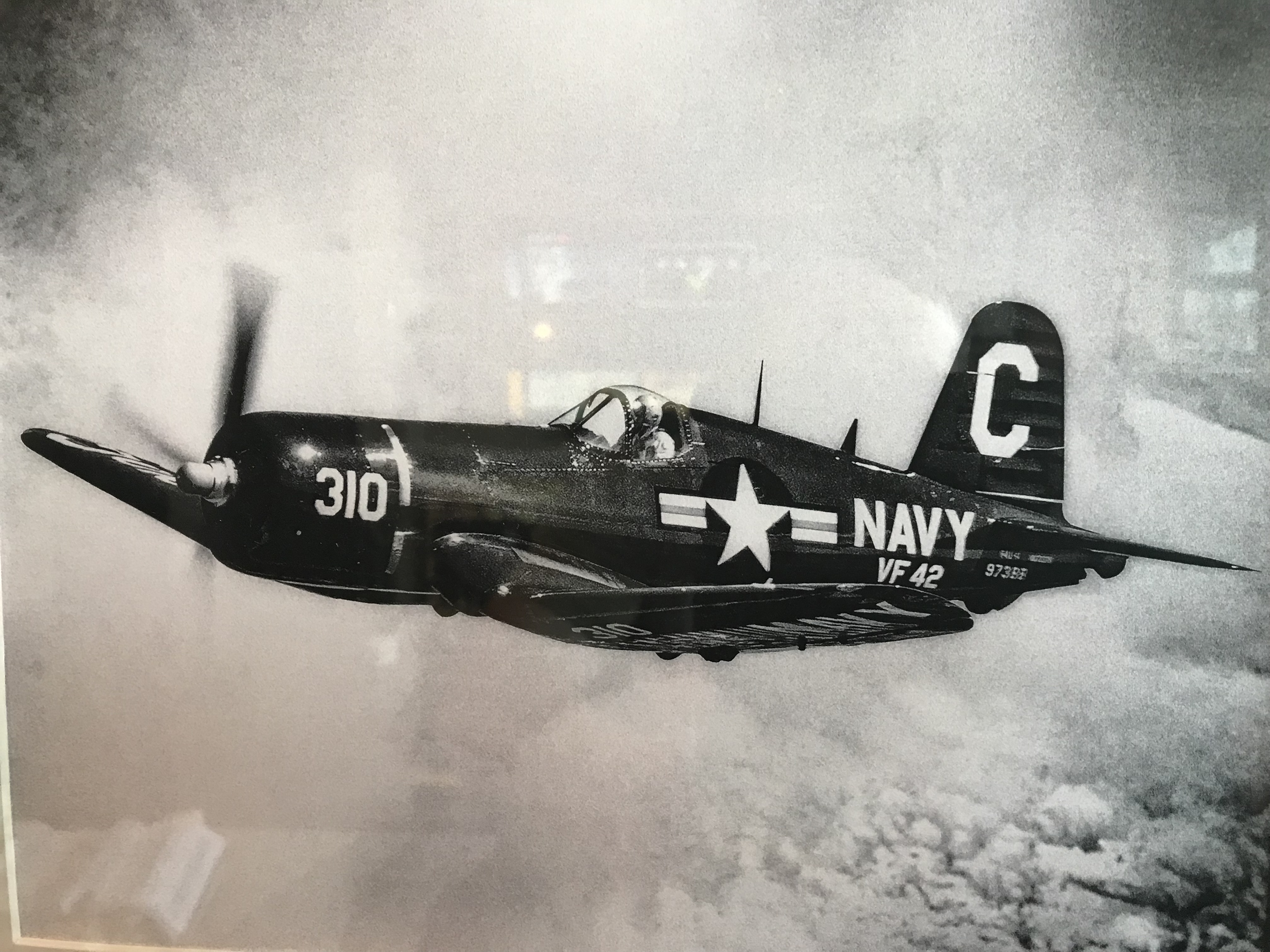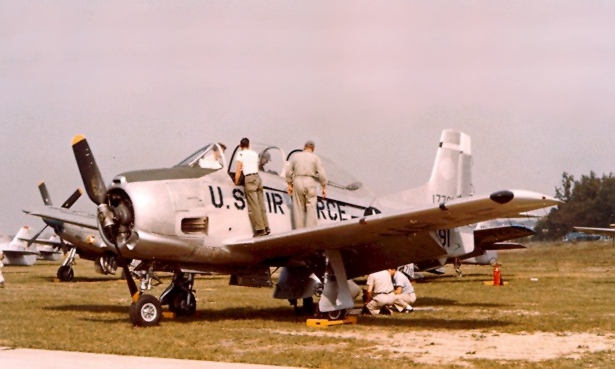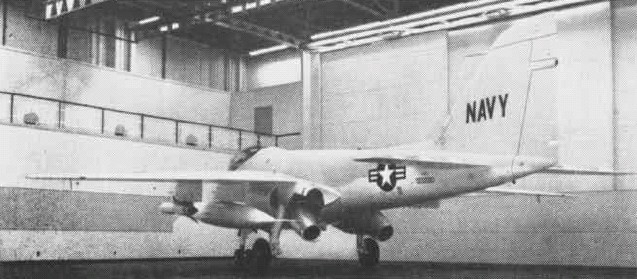|
Attack Squadron 42 (U.S. Navy)
Attack Squadron 42 (VA-42) was a United States Navy attack squadron based at Naval Air Station Oceana, Virginia. The squadron was established as Fighter Squadron 42 (VF-42) on 1 September 1950, redesignated as VA-42 on 1 November 1953 and disestablished on 30 September 1994. History "Green Pawn" nickname The insignia for VA-42, the "Green Pawn", was originally approved by the Chief of Naval Operations (CNO) for Bombing and Fighting Squadron 75 (VBF-75) on 28 October 1946. When VBF-75 was redesignated Fighting Squadron 4B (VF-4B) on November 15, 1946, the insignia was carried over for use by VF-4B. On 1 September 1948 VF-4B was redesignated Fighting Squadron 42 (VF-42). This squadron continued to use the Green Pawn insignia until it was disestablished on 8 June 1950. When a new Fighting Squadron 42 (VF-42) was established on 1 September 1950 they adopted the Green Pawn insignia that had been used by the former VF-42. In 1953 the insignia was carried over to VA-42 following its ... [...More Info...] [...Related Items...] OR: [Wikipedia] [Google] [Baidu] |
United States Department Of The Navy Seal
United may refer to: Places * United, Pennsylvania, an unincorporated community * United, West Virginia, an unincorporated community Arts and entertainment Films * ''United'' (2003 film), a Norwegian film * ''United'' (2011 film), a BBC Two film Literature * ''United!'' (novel), a 1973 children's novel by Michael Hardcastle Music * United (band), Japanese thrash metal band formed in 1981 Albums * ''United'' (Commodores album), 1986 * ''United'' (Dream Evil album), 2006 * ''United'' (Marvin Gaye and Tammi Terrell album), 1967 * ''United'' (Marian Gold album), 1996 * ''United'' (Phoenix album), 2000 * ''United'' (Woody Shaw album), 1981 Songs * "United" (Judas Priest song), 1980 * "United" (Prince Ital Joe and Marky Mark song), 1994 * "United" (Robbie Williams song), 2000 * "United", a song by Danish duo Nik & Jay featuring Lisa Rowe Television * ''United'' (TV series), a 1990 BBC Two documentary series * ''United!'', a soap opera that aired on BBC One from 1965-19 ... [...More Info...] [...Related Items...] OR: [Wikipedia] [Google] [Baidu] |
North American T-28 Trojan
The North American Aviation T-28 Trojan is a radial-engine military trainer aircraft manufactured by North American Aviation and used by the United States Air Force and United States Navy beginning in the 1950s. Besides its use as a trainer, the T-28 was successfully employed as a counter-insurgency aircraft, primarily during the Vietnam War. It has continued in civilian use as an aerobatics and warbird performer. Design and development On September 24, 1949, the XT-28 (company designation NA-159) was flown for the first time, designed to replace the T-6 Texan. The T-28A arrived at the Air Proving Ground, Eglin Air Force Base, Florida, in mid-June 1950, for suitability tests as an advanced trainer by the 3200th Fighter Test Squadron, with consideration given to its transition, instrument, and gunnery capabilities. Found satisfactory, a contract was issued and between 1950 and 1957, a total of 1,948 were built. Following the T-28's withdrawal from U.S. military service, a numb ... [...More Info...] [...Related Items...] OR: [Wikipedia] [Google] [Baidu] |
AGM-78 Standard ARM
The AGM-78 Standard ARM was an anti-radiation missile developed by General Dynamics, United States. It was built on the airframe of the RIM-66 Standard surface-to-air missile, resulting in a very large weapon with considerable range, allowing it to attack targets as much as away. Overview Originally developed for the US Navy during the late 1960s, the AGM-78 was created in large part because of the limitations of the AGM-45 Shrike, which suffered from a small warhead, limited range and a poor guidance system. General Dynamics was asked to create an air-launched ARM by modifying the RIM-66 SM-1 surface-to-air missile. This use of an "off the shelf" design greatly reduced development costs, and trials of the new weapon began in 1967 after only a year of development. The first operational missiles were issued in early 1968. The AGM-78 was nicknamed the "Starm", an abbreviation of Standard ARM. The first version of the missile, the A1 Mod 0, was little more than an air-launched RIM ... [...More Info...] [...Related Items...] OR: [Wikipedia] [Google] [Baidu] |
AIM-9 Sidewinder
The AIM-9 Sidewinder (where "AIM" stands for "Air Intercept Missile") is a short-range air-to-air missile which entered service with the US Navy in 1956 and subsequently was adopted by the US Air Force in 1964. Since then the Sidewinder has proved to be an enduring international success, and its latest variants remain standard equipment in most Western-aligned air forces. The Soviet K-13 (AA-2 'Atoll'), a reverse-engineered copy of the AIM-9B, was also widely adopted by a number of nations. Low-level development started in the late 1940s, emerging in the early 1950s as a guidance system for the modular Zuni rocket. This modularity allowed for the introduction of newer seekers and rocket motors, including the AIM-9C variant, which used semi-active radar homing and served as the basis of the AGM-122 Sidearm anti-radar missile. Originally a tail-chasing system, early models saw extensive use during the Vietnam War but had a low success rate. This led to all-aspect capabilities in ... [...More Info...] [...Related Items...] OR: [Wikipedia] [Google] [Baidu] |
Electronic Countermeasure
An electronic countermeasure (ECM) is an electrical or electronic device designed to trick or deceive radar, sonar, or other detection systems, like infrared (IR) or lasers. It may be used both offensively and defensively to deny targeting information to an enemy. The system may make many separate targets appear to the enemy, or make the real target appear to disappear or move about randomly. It is used effectively to protect aircraft from guided missiles. Most air forces use ECM to protect their aircraft from attack. It has also been deployed by military ships and recently on some advanced tanks to fool laser/IR guided missiles. It is frequently coupled with stealth advances so that the ECM systems have an easier job. Offensive ECM often takes the form of jamming. Self-protecting (defensive) ECM includes using blip enhancement Blip enhancement is an electronic warfare technique used to fool radar. When the radar transmits a burst of energy some of that energy is reflected off ... [...More Info...] [...Related Items...] OR: [Wikipedia] [Google] [Baidu] |
Grumman Gulfstream I
The Grumman Gulfstream I (company designation G-159) is a twin-turboprop business aircraft. It first flew on August 14, 1958. Design and development After first rejecting an idea to develop the Grumman Widgeon as an executive transport, the company studied producing an executive transport based on a turbine-powered variant of the naval utility transport Grumman TF-1 Trader. The company had already determined that any new aircraft would have to be turboprop-powered and the Rolls-Royce Dart engine was chosen. Further studies showed that the Trader-based design would not sell and they needed an all-new design with a low-wing and room to stand up in the cabin. In June 1957 the design of G-159 was finalised and Grumman started selling slots on the production line at $10,000 each. The initial customers worked with Grumman on the detailed design and avionics fit. The G-159 was given the name ''Gulfstream'' and on 14 August 1958 the first aircraft, registered ''N701G'', took off from B ... [...More Info...] [...Related Items...] OR: [Wikipedia] [Google] [Baidu] |
VMFA(AW)-242
The Virginia Museum of Fine Arts, or VMFA, is an art museum in Richmond, Virginia, United States, which opened in 1936. The museum is owned and operated by the Commonwealth of Virginia. Private donations, endowments, and funds are used for the support of specific programs and all acquisition of artwork, as well as additional general support. Considered among the largest art museums in North America for square footage of exhibition space, the VMFA's comprehensive art collection includes African art, American art, British sporting art, Fabergé, and Himalayan art. One of the first museums in the American South to be operated by state funds, VMFA offers free admission, except for special exhibits. The Virginia Museum of Fine Arts, together with the adjacent Virginia Historical Society, anchors the eponymous "Museum District" of Richmond, and area of the city known as "West of the Boulevard". The museum includes the Leslie Cheek Theater, a performing arts venue. For 50 years there ... [...More Info...] [...Related Items...] OR: [Wikipedia] [Google] [Baidu] |
A-6E Of VA-42 Launched From USS Lexington (AVT-16) 1984
The Grumman A-6 Intruder is an American twinjet all-weather attack aircraft developed and manufactured by American aircraft company Grumman Aerospace and operated by the U.S. Navy and U.S. Marine Corps. It was designed in response to a 1957 requirement issued by the Bureau of Aeronautics for an all-weather attack aircraft for Navy long-range interdiction missions and with short takeoff and landing (STOL) capability for Marine close air support. It was to replace the piston-engined Douglas A-1 Skyraider. The requirement allowed one or two engines, either turbojet or turboprop. The winning proposal from Grumman used two Pratt & Whitney J52 turbojet engines. The Intruder was the first Navy aircraft with an integrated airframe and weapons system. Operated by a crew of two in a side-by-side seating configuration, the workload was divided between the pilot and weapons officer (bombardier/navigator (BN)). In addition to conventional munitions, it could also carry nuclear weapons, wh ... [...More Info...] [...Related Items...] OR: [Wikipedia] [Google] [Baidu] |
Grumman A-6 Intruder
The Grumman A-6 Intruder is an American twinjet all-weather attack aircraft developed and manufactured by American aircraft company Grumman Aerospace and operated by the U.S. Navy and U.S. Marine Corps. It was designed in response to a 1957 requirement issued by the Bureau of Aeronautics for an all-weather attack aircraft for Navy long-range interdiction missions and with short takeoff and landing (STOL) capability for Marine close air support. It was to replace the piston-engined Douglas A-1 Skyraider. The requirement allowed one or two engines, either turbojet or turboprop. The winning proposal from Grumman used two Pratt & Whitney J52 turbojet engines. The Intruder was the first Navy aircraft with an integrated airframe and weapons system. Operated by a crew of two in a side-by-side seating configuration, the workload was divided between the pilot and weapons officer (bombardier/navigator (BN)). In addition to conventional munitions, it could also carry nuclear weapons, wh ... [...More Info...] [...Related Items...] OR: [Wikipedia] [Google] [Baidu] |
A-1 Skyraider
The Douglas A-1 Skyraider (formerly known as the AD Skyraider) is an American single-seat attack aircraft in service from 1946 to the early 1980s. The Skyraider had an unusually long career, remaining in front-line service well into the Jet Age (when most piston-engine attack or fighter aircraft were replaced by Jet aircraft); thus becoming known by some as an "anachronism". The aircraft was nicknamed "Spad", after the French World War I fighter. It was operated by the United States Navy (USN), the United States Marine Corps (USMC), and the United States Air Force (USAF), and also saw service with the British Royal Navy, the French Air Force, the Republic of Vietnam Air Force (RVNAF), and others. It remained in U.S. service until the early 1970s. The jet powered A-10 Thunderbolt II was based on specifications for a modernized Skyraider with a heavy payload and good endurance. Design and development The piston-engined, propeller-driven Skyraider was designed during World War I ... [...More Info...] [...Related Items...] OR: [Wikipedia] [Google] [Baidu] |
Azores
) , motto =( en, "Rather die free than subjected in peace") , anthem= ( en, "Anthem of the Azores") , image_map=Locator_map_of_Azores_in_EU.svg , map_alt=Location of the Azores within the European Union , map_caption=Location of the Azores within the European Union , subdivision_type=Sovereign state , subdivision_name=Portugal , established_title=Settlement , established_date=1432 , established_title3=Autonomous status , established_date3=30 April 1976 , official_languages=Portuguese , demonym= ( en, Azorean) , capital_type= Capitals , capital = Ponta Delgada (executive) Angra do Heroísmo (judicial) Horta (legislative) , largest_city = Ponta Delgada , government_type=Autonomous Region , leader_title1=Representative of the Republic , leader_name1=Pedro Manuel dos Reis Alves Catarino , leader_title2= President of the Legislative Assembly , leader_name2= Luís Garcia , leader_title3= President of the Regional Government , leader_name3=José Manuel Bolieiro , le ... [...More Info...] [...Related Items...] OR: [Wikipedia] [Google] [Baidu] |
Lajes Field
Lajes Field or Lajes Air Base (; pt, Base Aérea das Lajes), officially designated Air Base No. 4 (''Base Aérea Nº 4'', BA4) , is a multi-use airfield near Lajes and northeast of Angra do Heroísmo on Terceira Island in the Azores, Portugal. It is home to the Portuguese Air Force ''Base Aérea N º4'' and Azores Air Zone Command ( pt, Comando da Zona Aérea dos Açores), a United States Air Force detachment unit (operated by the 65th Air Base Group of United States Air Forces in Europe - Air Forces Africa), and a regional air passenger terminal. Located about east of New York City and about west of Lisbon, Portugal; the base sits in a strategic location midway between North America and Europe in the north Atlantic Ocean. History The origin of the Lajes Field dates back to 1928, when Portuguese Army Lieutenant colonel Eduardo Gomes da Silva wrote a report on the possible construction of an airfield in the plainland of Lajes, for that branch's aviation service ( pt, Aeron ... [...More Info...] [...Related Items...] OR: [Wikipedia] [Google] [Baidu] |







_(cropped).jpg)
